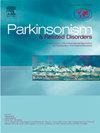丘脑底核深部脑刺激对帕金森病患者言语指标的影响
IF 3.4
3区 医学
Q2 CLINICAL NEUROLOGY
引用次数: 0
摘要
语言障碍是帕金森病(PD)的常见症状。序列效应,持续运动速度或幅度的进行性恶化,是PD独有的,对多巴胺能治疗反应不佳。虽然丘脑下核深部脑刺激(STN DBS)可以改善PD的各种运动症状,但其对言语和言语序列效应的影响尚不清楚。在这里,我们研究了STN DBS对PD患者语音指标的影响,包括序列效应。方法15例PD患者行双侧STN DBS手术。我们使用了持续发声(SP)测试和双代代动力学(DDK)测试,在关闭和打开两种刺激条件下进行。主要结果测量包括总SP持续时间、平均强度、DDK率和言语序列效应。结果stn DBS可显著提高SP持续时间,但未改变平均强度。它还提高了/pa/的DDK音节产生率。然而,它并没有显著改变语音序列效果。结论STN DBS可以增强部分语音参数,但不能显著减轻语音序列效应。需要进一步的研究纳入更全面和功能性的言语评估,以更好地了解DBS对言语的更广泛影响,并指导PD患者言语障碍的个性化治疗策略。本文章由计算机程序翻译,如有差异,请以英文原文为准。
The effect of subthalamic nucleus deep brain stimulation on speech metrics in Parkinson's disease
Background
Speech impairment frequently occurs in Parkinson's disease (PD). The sequence effect, progressive deterioration in speed or amplitude of ongoing movement, is unique to PD and does not respond well to dopaminergic therapy. While subthalamic nucleus deep brain stimulation (STN DBS) can improve various motor symptoms in PD, its impact on speech and the speech sequence effect remains unclear. Here, we investigated the effects of STN DBS on speech metrics including the sequence effect in people with PD.
Methods
Fifteen individuals with PD who underwent bilateral STN DBS surgery participated in this study. We utilized the sustained phonation (SP) test and the diadochokinetic (DDK) test, which were performed under both OFF and ON stimulation conditions. Primary outcome measures included total SP duration, mean intensity, DDK rates, and the speech sequence effect.
Results
STN DBS significantly improved the duration of SP without altering mean intensity. It also improved the rate of DDK syllable production for /pa/. However, it did not significantly change the speech sequence effect.
Conclusions
These findings indicate that while STN DBS can enhance certain speech parameters, it does not significantly mitigate the speech sequence effect. Further studies incorporating more comprehensive and functional speech assessment are needed to better understand the broader impact of DBS on speech and guide personalized treatment strategies for speech impairment in PD.
求助全文
通过发布文献求助,成功后即可免费获取论文全文。
去求助
来源期刊

Parkinsonism & related disorders
医学-临床神经学
CiteScore
6.20
自引率
4.90%
发文量
292
审稿时长
39 days
期刊介绍:
Parkinsonism & Related Disorders publishes the results of basic and clinical research contributing to the understanding, diagnosis and treatment of all neurodegenerative syndromes in which Parkinsonism, Essential Tremor or related movement disorders may be a feature. Regular features will include: Review Articles, Point of View articles, Full-length Articles, Short Communications, Case Reports and Letter to the Editor.
 求助内容:
求助内容: 应助结果提醒方式:
应助结果提醒方式:


